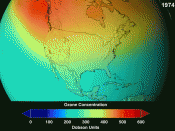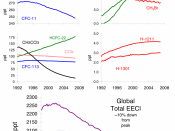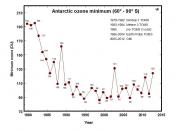I decided to investigate the environmental issue of the depletion of the ozone. Although I have heard many things about the ozone, and the hole over Antarctica, I wanted to find out more and get some real facts on ozone depletion and what we can do about it.
The ozone layer refers to the ozone within the stratosphere, where over 90% of the earth's ozone resides. The ozone layer absorbs 97-99% of the sun's ultraviolet or UV light ("The Ozone Layer"). This UV light has many damaging affects for humans, plants, and animals. In humans, exposure to UV light can increase the chances of getting skin cancer and cataracts. It also harms food crops and other plants, as well as many animals (Albritton, et al).
There are several factors influencing concentrations of ozone. Some of these are natural, which appear to cause minor fluctuations. Some of the factors are manmade and can cause major changes to the ozone layer.
One natural influence is large explosive volcanoes. An eruption places aerosols and chlorine into the lower stratosphere. Although this can have major effects on localized weather patterns, the effect on global ozone is almost insignificant and only lasts 2-3 years. Stratospheric winds and greenhouse gases are also natural influences on the ozone concentration. The variations in how much UV radiation is given off from the sun also affects the ozone, but it is a negligible amount. Stratospheric chlorine is a major influence on the ozone and comes mostly from manmade halocarbons. Catalytic degradation by stratospheric chlorine leads to a 3% decrease in ozone per decade, proven by studies done from 1978-1991 ("The Ozone Layer"). I will consider the manmade problems more later when I discuss chlorofluorocarbons.
Beginning in the early 1970's, scientists discovered two potential manmade problems affecting the ozone. The...



Pretty good.
I would not use first person in the opening paragraph. In the rest he seems to limit the use of I but I would get rid of it totally. All in all pretty good content.
0 out of 0 people found this comment useful.